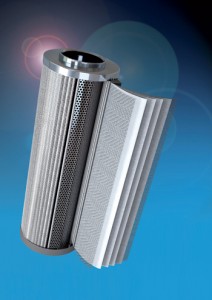By Josh Cosford
Fluid conditioning is the top priority for those intending to keep their hydraulic machines happy and reliable. Control of the various forms of fluid contamination ensures components will run within their design criteria efficiently and dependably. Major forms of fluid contamination include water, air, heat and particle.
 Particle contamination is often highest during machine startup, where the remains of cutting, grinding and welding have found homes in the nooks and crannies of reservoirs, manifolds, hoses and actuators. Contamination can spike once again during careless maintenance or catastrophic component failure. Luckily, particle contamination is extremely easy to control, which makes it all the more shocking when people don’t take filtration seriously.
Particle contamination is often highest during machine startup, where the remains of cutting, grinding and welding have found homes in the nooks and crannies of reservoirs, manifolds, hoses and actuators. Contamination can spike once again during careless maintenance or catastrophic component failure. Luckily, particle contamination is extremely easy to control, which makes it all the more shocking when people don’t take filtration seriously.
Every hydraulic machine requires fluid filtration, and there are three major types; suction filters, pressure filters and return filters. Suction filters are mounted inside the hydraulic reservoir on the suction tube as a primary defense against larger chunks, but are made of steel mesh and limited in their capacity to reduce the finer wear-causing particles. The use of suction filters is also a bone of contention, as some feel they cause more problems than they solve, such as becoming clogged and creating pump cavitation.
Pressure filters are installed downstream of pumps or in sub-circuits of the system requiring different, and often finer, levels of filtration than the rest of the circuit. Installed after the pump, a pressure filter can protect all the components downstream from anything ingested by the pump. Depending on how they are rated from their manufacturer, pressure filters can range from 500 to 10,000 psi and higher, adding insurance in even the most demanding hydraulic application.
Return filters are the most common form of fluid protection in a hydraulic system, and are normally either spin-on filter assemblies or in-tank drop-in assemblies. The venerable spin-on filter resides on the vast majority of mobile machinery, and is available in low- to mid-range quality filter media. They are sometimes outfitted with water absorbing filter media, which can remove freestanding water from oil, if such a problem is a concern.
In-tank return filters, previously the realm of industrial hydraulics only, have infiltrated the mobile market as well. They offer medium- to high-quality filter media in a convenient and space-saving mounting configuration. Their location in the fluid stream, as with spin-on return filters, allows them to remove many of the particles created or ingested by the rest of the system, leaving a reservoir full of sparkly-clean oil.
Filters are classified by the smallest size of particles they reasonably remove from the oil in one pass through the element, such as “10 µm.” It is important when discussing filtration quality that the efficiency is stated for which the rating was classified. For example, a 10-µm filter requires we know how efficient it was at removing 10-µm particles in a single pass, such as 99%. Efficiency is often expressed as a beta ratio, which is the ratio of particles upstream of the filter to downstream of the filter during standardized testing; for example, “10 µm at Beta 200,” which means 99.5% efficient at removing 10-µm particles in one pass. Obviously, lower micron filtration and higher efficiency is ideal, although price can be a consideration as filtration quality rises. Finer filtration is more restrictive, so attention to pressure drop detail should be paid, just as sizing any filter to be appropriate for the flow of the circuit should be considered.

